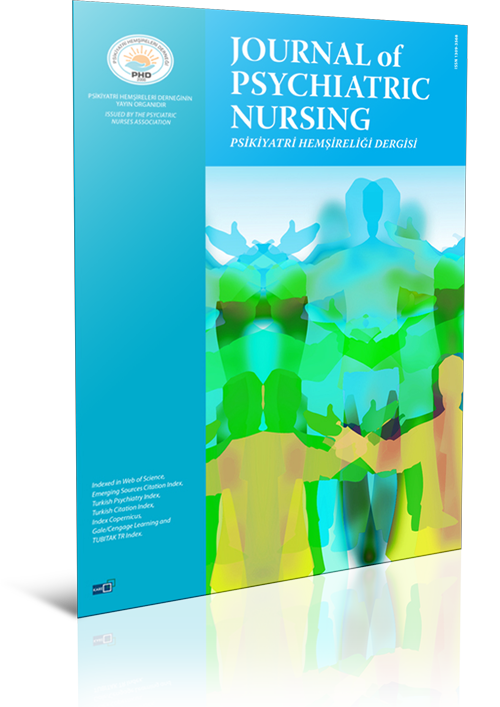
Volume: 2 Issue: 3 - 2011
| 1. | Frontmatter Pages I - III |
| RESEARCH ARTICLE | |
| 2. | Drug Compliance of Patients Hospitalized in the Psychiatry Clinic and the Relationship with Social Support Meral Kelleci, Elvan E. Ata Pages 105 - 110 OBJECTIVE: This study was carried out in order to determine drug compliance among patients hospitalized in the psychiatry clinic and the relationship with social support. METHODS: The sample of the study was composed of 140 patients hospitalized in the clinic between April 2009 - March 2010, who accepted to take part in the study and had no problems in comprehension or communication. Data of the study were obtained with the Personal Information Form, Morisky Adherence Scale and Multidimensional Scale of Perceived Social Support. Data of the research were obtained during a face-to-face interview. For analysis of the data, variance analysis, correlation and frequency distribution were used. RESULTS: The average age of the patients was 37.20±12.82 years, 51.4% were female, 53.6% were married, 44.3% were primary school graduates, 25.7% were high school graduates, 62.1% had mid-level economic status, and 67.1% lived with their immediate family. The average duration of the patients disease was 8.35±8.11 years, and the average number of hospitalizations was 3.25±2.08. Drug compliance was good in 20% of the patients, moderate in 48.6% and poor in 31.4%. When the average score of the Multidimensional Scale of Perceived Social Support was evaluated according to the drug compliance of patients, it was determined that there was little difference between groups with regards to family support; however, there was a statistically significant difference between groups regarding the sub-dimensions of support of a friend or someone special (p<0.05). There was a weak relation, statistically significant and positive, between support of a friend and drug compliance (r=0.272, p=0.001). CONCLUSION: Based on the results of the study, it was determined that drug compliance of most patients was inadequate. The drug compliance score of patients who feel the support of a friend or someone special was high, and there was a relation, though weak, between support of a friend and drug compliance. |
| 3. | Examining the Mode of Anger Expression in Adolescents with Psychiatric Disorders and their Parents Demet Taşçı Eser, Besti Üstün Pages 111 - 116 OBJECTIVE: The purpose of this study was to examine anger expression between adolescents with psychiatric disorders and their parents. METHODS: The test group consisted of adolescents between the ages of 15-18 years and their families registered at Ege University Medical Faculty Hospital, Adolescent Mental Health Consultation and Treatment Unit. A demographic questionnaire and an Anger Expression Scale, which was developed by Spielberger and adapted to Turkish by Özer, were used for collecting data. One-way analysis of ANOVA was applied. Additionally, Tukey-HSD test was conducted when the results of ANOVA were significant. RESULTS: When the results of the study were examined in terms of levels of anger, adolescents diagnosed with psychiatric disorders did not demonstrate statistical differences from their mothers and fathers concerning trait anger and inward reflection of anger. In terms of outward reflection of anger, adolescents diagnosed with psychiatric disorders did not demonstrate statistical differences in comparison to their fathers, but their outward reflection of anger was higher than that of their mothers. In terms of anger control, adolescents diagnosed with psychiatric disorders did not demonstrate statistical differences from their mothers, but the fathers were better in controlling anger than the adolescents. CONCLUSION: Based on the study results, anger management programs are recommended for adolescents and their parents. |
| 4. | Evaluation According to the Functional Health Pattern Model and NANDA Diagnoses of Patient Care Plans Made by Nurses in a Psychiatry Department Selma Sabancıoğulları, Elvan E. Ata, Meral Kelleci, Selma Doğan Pages 117 - 122 OBJECTIVE: The aim of the study was to analyze patient care planning prepared by nurses in a psychiatry clinic according to the Functional Health Pattern (FHP) model and to evaluate the NANDA (North American Nursing Diagnosis Association) nursing diagnoses based on the data collected. METHODS: This retrospective and descriptive research was carried out in a psychiatry clinic of a university hospital. The sample of this research was the nursing plan of 80 inpatients hospitalized in the psychiatry clinic between September 2008 and June 2009 and the determined nursing diagnoses in the direction of Gordons (1982) FHP model and NANDA. Care plans made by nurses were retrospectively analyzed by researchers taking into consideration the FSO model and NANDA diagnosis system. The data were evaluated with percentage distribution. RESULTS: Nurses collected the most data related to perceiving and managing the health (98.8%) function and activity-exercise (91.3%) function, and the least data concerning sexuality and reproduction (20%) function. When NANDA diagnoses were evaluated according to data collected by nurses, 23 different NANDA diagnoses were determined among 80 patients, and 402 NANDA diagnoses in total. When the determined diagnoses were analyzed, the most frequently observed were: 12.9% inadequacy in individual coping, 11.2% decrease in self-esteem, 10.4% failure in role performance, and 9% disorder in sleep pattern. CONCLUSION: It may be considered that nurses, when they used the FHP model, did not overlook the important data in evaluating the problems the psychiatric patients frequently experienced, such as inadequacy in individual coping, decrease in self-esteem, disorder in sleep pattern, and ineffective management of therapeutic regimen. However, it was observed that nurses evaluate fields such as sexual pattern and values and beliefs to a lesser degree and detect fewer problems in these areas. |
| 5. | Examination of the Relationship Between Critical Thinking Disposition and Academic Success of Nursing Students Yalçın Kanbay, Elif Işık, Özgür Aslan Pages 123 - 127 OBJECTIVE: This study was conducted descriptively to examine the relationship between critical thinking disposition and academic achievement of nursing students. METHODS: The universe of the study consisted of 281 nursing students in a four-year health high school who were educated with a conventional learning method, and the sampling consisted of 249 students. As data collection tools, the California Critical Thinking Disposition Inventory and transcripts of the students were used. In order to study the relationship between variables, correlation analysis was used, while analysis of variance was used to evaluate the difference between the groups. RESULTS: The critical thinking disposition mean score of the nursing students was determined as 261.95 points. The relationship between critical thinking disposition scores of the students and their academic achievement was not statistically significant (p>0.05). However, critical thinking disposition scores of 1st and 2nd year students were significantly higher than the scores of 3rd and 4th year students (p<0.05). CONCLUSION: Critical thinking disposition scores of the nursing students were determined as moderate, no statistically significant relationship was found between critical thinking disposition and academic achievement, and finally, 1st and 2nd year nursing students were more successful than 3rd and 4th year students in terms of critical thinking. Based on these results, in an effort to graduate students with higher critical skills, it is suggested to supplement the current curricula with new courses aimed toward improving the critical thinking capabilities of the students. Furthermore, longitudinal studies to determine the development of the critical thinking disposition of the students should be conducted. |
| 6. | Ideas Regarding Psychotropic Drug Use among Inpatients in a Psychiatry Clinic and after Their Discharge from the Hospital with Follow-Up by Telephone Meral Kelleci, Selma Doğan, Elvan E. Ata, Dilek Avcı, Selma Sabancıoğulları, Filiz Başeğmez, Meral İşkey Pages 128 - 135 OBJECTIVE: This study aimed to examine the need for training among inpatients in a psychiatric clinic and their families on psychotropic drug use and to determine the drug compliance status after the patients discharge from the hospital. METHODS: The study was conducted at a psychiatric clinic of a university hospital. The respondents were 92 patients who were hospitalized from July 2008 to March 2009, who were willing to respond and who did not have any problems in comprehending or replying to the questions. The data were collected through a form covering details of the patients and their families. The form consisted of 56 questions regarding the patients demographic details, drug therapies, and the views of the patients and their families about drug therapies and drugs. The data were collected face-to-face after the acute stage. The patients were contacted by telephone at one month and six months following their discharge from the hospital. RESULTS: The patients were identified with the symptoms of bipolar affective disorder (31.5%), schizophrenia (26.1%), psychotic disorders (26.1%), paranoid disorders (5.4%), and psychotic depression (2.2%). It was discovered that 40.2% of the patients did not know their diagnosis, 12% did not think drugs were necessary, 17.4% did not know the names of their drugs, 23.9% did not know the dose of their drugs, 19.6% believed the drugs would cause addiction, 17.4% did not plan to use the drugs after being discharged from the hospital, and 64.1% did not know for how long they should continue taking the drugs. In the first monitoring by telephone, 70.6% of the patients said they used their drugs regularly. 39.1% of the patients were re-hospitalized in the first six months after discharge due to not using the drugs regularly. In the second monitoring by telephone, 54.3% of those who were not re-hospitalized in the first six months stated that they used their drugs regularly. CONCLUSION: The results of this study indicate the need for training among patients on drug management. This training should not be limited to in-hospital; there is a need for counseling at home after discharge from the hospital, and the current system remains inadequate. |
| REVIEW | |
| 7. | Stigma Process and Internalized Stigma among Individuals with Mental Illness Olcay Çam, Döndü Çuhadar Pages 136 - 140 Stigma is described as a loss of social status and discrimination triggered by negative stereotypes that have become linked in a particular society to a particular human characteristic, such as mental illness. Stigmatization can be harmful to the stigmatized person by affecting them via their internal perceptions, beliefs and emotions. When an individual with a severe mental illness label believes that society rejects and devalues those with mental illness, these patients suffer a number of negative outcomes, such as demoralization, lowered self-esteem, impaired social adaptation, unemployment, income loss, and reduced compliance to psychiatric medication. Most people with mental illness are aware of the stigma in society about mental illness, and some of these patients confirm the stigma towards them, and as a result, stigmatize themselves. Internalized stigma is the devaluation, shame, secrecy, and withdrawal resulting from the adaptation of negative stereotypes to oneself. People with mental illness who internalize stigma are more isolated, alienated and socially withdrawn. Internalized stigma worsens symptoms and impedes recovery. Internalized stigma is one of the outcomes of stigma, and it is thus an issue that mental health professionals should assess in order to devise appropriate intervention plans towards its prevention. The aim of this article was to provide a viewpoint regarding internalized stigma and coping skills. |
| 8. | Stigma Starts Early: The Role of Education among Young People Combating Stigma about Mental Illnesses Gül Oban, Leyla Küçük Pages 141 - 148 Most psychiatric disorders begin during adolescence and manifest in early adulthood. One important barrier to mental health treatment for adolescents is the associated stigma. Not receiving psychiatric help during adulthood because of stigma can contribute to the development of chronic mental disorders and a negative prognosis. Education programs on the issue of stigma would ensure the community is better informed about mental disorders. Empirical studies of anti-stigma interventions among young people show that education programs can help to decrease stigma. The purpose of this study was to review and discuss the effects of education aimed at informing young people about mental disorders on social distance and attitude in national and international dimensions. The key words stigmatization, adolescent, education, social distance and attitude were searched in PubMed and Türk Psikiyatri Dizini, and a total of 26 research articles were evaluated. |


















